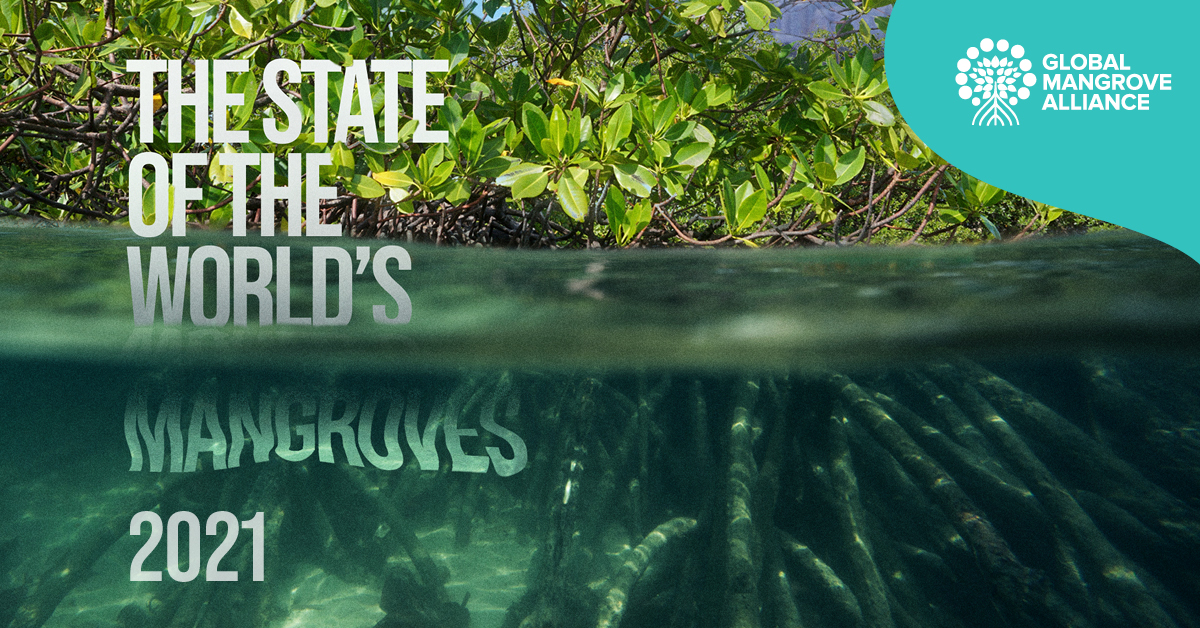Global Mangrove Alliance launches the first State of the World’s Mangroves Report
A comprehensive new report by the Global Mangrove Alliance, with the help of over 100 mangrove science, finance, and policy experts from around the world, highlights benefits, stories, and global trends - and sets out a pathway for the way ahead.

Photo: Global Mangrove Alliance
Mangrove forests are critical ecosystems, both for biodiversity and for humanity. Vast areas have been lost, but things are changing. As we begin to realize their full value—as carbon stores, fish factories, coastal defenses and more—efforts are being made to protect what remains, and to start programs of restoration.
A comprehensive new report by the Global Mangrove Alliance (GMA), with the help of over 100 mangrove science, finance, and policy experts from around the world, highlights benefits, stories, and global trends - and sets out a pathway for the way ahead. The GMA is a joint effort of 27 organizations, including IUCN, working to accelerate mangrove conservation and restoration efforts around the world.
The State of the World’s Mangroves provides the very latest information on what we know about mangroves and what’s being done to support these magnificent habitats.
Given the critical importance of mangroves for the maintenance of both a healthy planet and a healthy ocean, I encourage governments, corporations, cities and people around the world to support the objectives and efforts of the Global Mangrove Alliance. As we emerge from the COVID-19 pandemic, it is more important than ever to include the protection and restoration of mangrove forests in our action plans for a blue-green recovery. -
Ambassador Peter Thomson
UN Secretary General’s Special Envoy for the Ocean
The State of Mangroves
While mangrove losses in the last 25 years were considerable, the rates of loss are declining worldwide. Thanks to the Global Mangrove Watch, we can study ecosystem change over time, providing a critical baseline from which we continue to learn about mangrove benefits, loss, and expansion.
Since 2000, over 60% of mangrove losses were due primarily to direct and indirect human impacts mostly occurring in Indonesia, Myanmar, Malaysia, the Philippines, Thailand, and Vietnam. Naturally driven events such as erosion, sea level rise, hurricanes and drought—exacerbated by climate change—are also leading to loss.
There were 136,000 km2 of mangroves worldwide in 2016, with new global estimates releasing soon. The declining rates of loss should provide hope—mangroves are often opportunistic, and expansion can occur relatively fast. Recent gains are likely mostly due to natural propagation with restoration projects providing additional help.
Over the last 20 years, mangrove forests have shifted from being one of the fastest-diminishing habitats on Earth to being one of the best protected. Over 6,600 km2 are still highly restorable but will require long-term funding to communities. IUCN, through the Global Mangrove Alliance, is collaborating across the mangrove community to develop tools that can maximize restoration success.
Living with Mangroves
At the center of mangrove restoration, protection and sustainable use are people. Humans and mangroves have a long history of thriving together. Coastal communities can ensure mangroves’ long-term sustainable use—in large part because of benefits they gain from conservation, like food and job security, and improved livelihoods.
Mangroves are home to 341 threatened species and support over 4.1 million fishers globally. They prevent more than $65 billion in property damages and reduce flood risk to some 15 million people every year. In the face of climate change mangroves can be superheroes, converting carbon dioxide to organic carbon at higher rates than almost any other habitat on earth and supporting lives and livelihoods that would be much more gravely affected by our changing climate without them.
Throughout the State of the World’s Mangroves report are 25 mangrove stories from different countries that highlight the many ways communities are living alongside their mangroves. From community restoration efforts, to new management and governance systems working to secure traditional livelihoods, to engaging and empowering communities through valuable participatory approaches – it is evident that communities across the world are fighting to secure a better future for their mangroves.
The State of the World’s Mangrove report executive summary is available in English, Spanish, French, Chinese, Arabic, Hindi, Indonesian and Portuguese.
The Way Ahead
There is an urgent need to protect remaining mangroves, to enhance recovery and restore lost forests. Such actions will support coastal communities, jobs and food security, alongside providing global climate mitigation benefits.
We are now able to monitor mangroves like never before. In a shift from reactive to proactive, the Global Mangrove Alliance is collaborating within our membership and with governments and other stakeholders to identify where the most significant conservation opportunities are and bring them to scale.
Alongside credible, robust, and transparent data, sharing examples of the practicalities and potential of different management interventions is further strengthening the hand of policy-makers. A key to success is policies that work with local Indigenous peoples, coastal communities, and small-scale fishers.
It is essential to ensure that decisions about the use of—and access to—mangroves are made fairly and equitably when empowering communities. Taking into account the needs of those already using and dependent upon mangroves, in many cases indigenous people and women, is key to long-term success.
Many benefits of conserving and restoring mangroves can be further underpinned by strong financial arguments of the economic gains mangroves provide. But to meet the global conservation funding gap, it is estimated that $11.1 billion will be necessary over the next twenty years to restore mangroves worldwide.
The way ahead is rooted in collaboration. The Global Mangrove Alliance is committed to its focus on halting any ongoing mangrove loss, advancing science-based restoration and increasing public awareness, to increase effective and equitable protection of mangroves and expand restoration.
The full State of the World’s Mangroves report can be found here.
Learn more about IUCN’s work on conserving and protecting mangroves by viewing the Save Our Mangroves Now! Roots of Hope campaign launch video here.
Stay tuned for more information on Mangroves at the IUCN World Conservation Congress:
IUCN Motion 093 - Conservation, restoration and sustainable management of mangrove ecosystems
Forum Session: Mangrove and Blue Carbon Conservation and Restoration – Successes in the Swamp
Forum Session: Taking Climate Action through Increasing Mangrove Cover: The State of the World’s Mangroves
About The Global Mangrove Alliance
In 2018 Conservation International (CI), the International Union for Conservation of Nature (IUCN), The Nature Conservancy (TNC), Wetlands International, and World Wildlife Fund (WWF) formed the Global Mangrove Alliance (GMA). This partnership now includes over 25 member organizations that share the aim of scaling up the recovery of mangroves through equitable and effective expansion of both mangrove protection and the restoration of former mangrove areas. From a practical perspective, the GMA works worldwide in supporting research, advocacy, education and practical projects on the ground with local and community partners.
For more information, see the Global Mangrove Alliance website and the Global Mangrove Watch platform.



